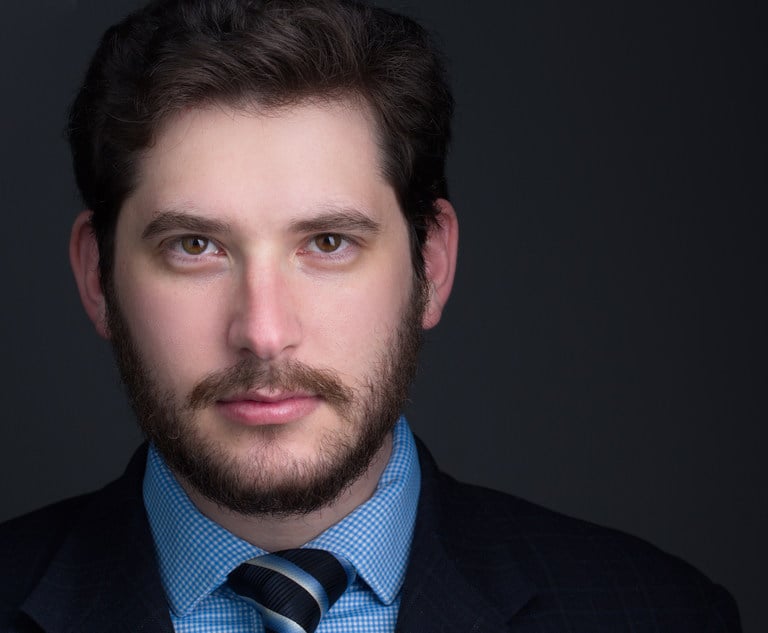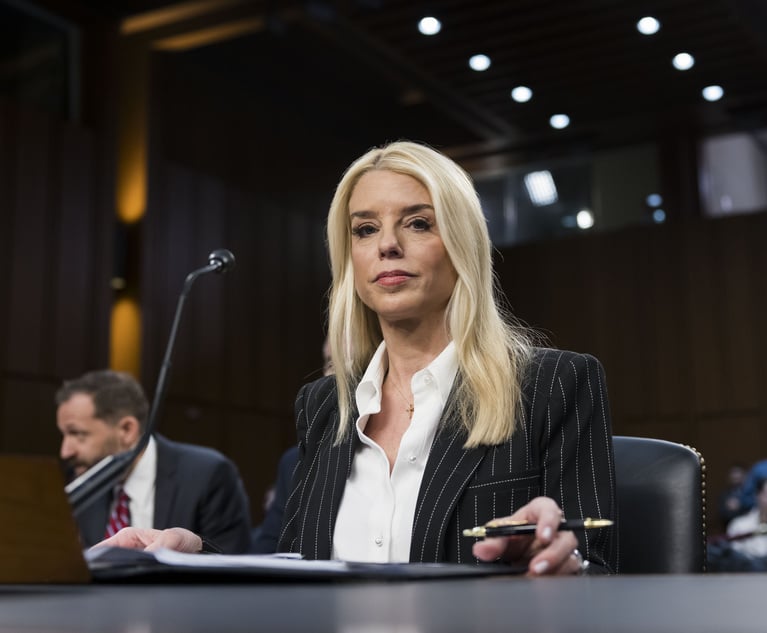Florida Justices Question Whether Time Is Right to Adopt Daubert Standard
In a closely watched asbestos case, Florida Supreme Court justices seemed unsure about switching away from the Frye standard.
March 06, 2018 at 12:38 PM
4 minute read

The Florida Supreme Court didn't seem quite ready Tuesday to officially adopt the Daubert evidence standard five years after the state Legislature wrote the rule change into law.
During oral argument in DeLisle v. Crane, the court's more conservative justices questioned whether plaintiffs attorneys brought the right case to challenge Daubert, which asks trial judges to ensure admitted scientific evidence is relevant and reliable. The liberal-leaning justices fretted about the standard's potential effect on plaintiffs compared with the Frye test, which asks whether new or novel evidence is based on generally accepted science.
Justices Charles Canady and C. Alan Lawson grilled Miami attorney Jim Ferraro, who sought to reinstate an $8 million asbestos verdict his firm won for Richard DeLisle. The award was overturned in 2016 when the Fourth District Court of Appeal in West Palm Beach found some of the plaintiff's expert testimony did not meet the Daubert standard.
The standard is used in federal courts and most state courts.
Canady said he was “struggling” to find a conflict that would establish the high court's jurisdiction in the case. Ferraro argued the conflict was the Fourth DCA's application of Daubert even though the standard had not been adopted by the Florida Supreme Court.
“Our conflict jurisdiction is not about a conflict between a statute and an earlier version of the law,” Canady said. ”It's about conflict between courts. … I cannot follow the workings of your mind on this issue.”
The respondents were right in line with Canady on that point.
“I'm fairly certain there will be a case that will be developed that will bring and preserve these issues to the court,” said Richard Doran of Ausley McMullen in Tallahassee, who represented respondent Crane Co. “This is not the case.”
JURY FUNCTION
But other justices had questions for Doran and Greenberg Traurig attorney Elliot Scherker, who represented the other respondent, R.J. Reynolds Tobacco Co.
Justice Barbara Pariente worried the Daubert standard could allow a trial judge to “usurp the jury's function” by excluding expert testimony, especially considering R.J. Reynolds' own documents said certain cigarettes released asbestos in the early 1950s when DeLisle smoked them.
“Was this testimony so fallacious that the jury would not be able to evaluate the solidity of the expert opinions on causation?” Pariente asked.
Scherker said the documents showed no more exposure to asbestos than in the air on an average day in New York City in 1954. The excluded plaintiffs expert testimony relied on a methodology that was not peer reviewed and wouldn't even have passed the Frye test, he added.
“The line between Daubert and Frye is exceedingly thin,” Scherker said. “With apologies to Gertrude Stein, junk science is junk science is junk science.”
Pariente said she had “trouble” finding DeLisle's case relied on junk science because of years of studies linking asbestos exposure to mesothelioma.
“There's no question that for 50-plus years, the product asbestos in different forms is the primary reason that individuals develop the disease that Mr. DeLisle had,” she said. “So when we're talking about junk science or whatever, there are plaintiffs, there are individuals all over the country who become sick and die because of this product.”
Doran argued DeLisle's attorneys did not meet the burden of showing he was exposed to disease-causing levels of asbestos in Crane's products during a factory job: “Nobody captured the dust cloud” and measured the amount of asbestos in it, he said.
Justice R. Fred Lewis worried about plaintiffs carrying a heavy burden of proof, especially when it comes to determining the level of asbestos that causes harm.
“Let's just separate all this talky-talk,” he said. “That's just contrary to common sense that we're going to do experiments on humans with toxic substances.”
Last year, the court declined to adopt the Daubert amendment, finding a rule change would raise constitutional concerns that “must be left for a proper case or controversy.”
This content has been archived. It is available through our partners, LexisNexis® and Bloomberg Law.
To view this content, please continue to their sites.
Not a Lexis Subscriber?
Subscribe Now
Not a Bloomberg Law Subscriber?
Subscribe Now
NOT FOR REPRINT
© 2025 ALM Global, LLC, All Rights Reserved. Request academic re-use from www.copyright.com. All other uses, submit a request to [email protected]. For more information visit Asset & Logo Licensing.
You Might Like
View All
Tragedy on I-95: Florida Lawsuit Against Horizon Freight System Could Set New Precedent in Crash Cases
2 minute read
'You Lied to the Jury': Veteran Awarded $5 Million in Defamation Case Against CNN
4 minute read
Vedder Price Shareholder Javier Lopez Appointed to Miami Planning, Zoning & Appeals Board
2 minute readTrending Stories
- 1Paul Hastings, Recruiting From Davis Polk, Continues Finance Practice Build
- 2Chancery: Common Stock Worthless in 'Jacobson v. Akademos' and Transaction Was Entirely Fair
- 3'We Neither Like Nor Dislike the Fifth Circuit'
- 4Local Boutique Expands Significantly, Hiring Litigator Who Won $63M Verdict Against City of Miami Commissioner
- 5Senior Associates' Billing Rates See The Biggest Jump
Who Got The Work
J. Brugh Lower of Gibbons has entered an appearance for industrial equipment supplier Devco Corporation in a pending trademark infringement lawsuit. The suit, accusing the defendant of selling knock-off Graco products, was filed Dec. 18 in New Jersey District Court by Rivkin Radler on behalf of Graco Inc. and Graco Minnesota. The case, assigned to U.S. District Judge Zahid N. Quraishi, is 3:24-cv-11294, Graco Inc. et al v. Devco Corporation.
Who Got The Work
Rebecca Maller-Stein and Kent A. Yalowitz of Arnold & Porter Kaye Scholer have entered their appearances for Hanaco Venture Capital and its executives, Lior Prosor and David Frankel, in a pending securities lawsuit. The action, filed on Dec. 24 in New York Southern District Court by Zell, Aron & Co. on behalf of Goldeneye Advisors, accuses the defendants of negligently and fraudulently managing the plaintiff's $1 million investment. The case, assigned to U.S. District Judge Vernon S. Broderick, is 1:24-cv-09918, Goldeneye Advisors, LLC v. Hanaco Venture Capital, Ltd. et al.
Who Got The Work
Attorneys from A&O Shearman has stepped in as defense counsel for Toronto-Dominion Bank and other defendants in a pending securities class action. The suit, filed Dec. 11 in New York Southern District Court by Bleichmar Fonti & Auld, accuses the defendants of concealing the bank's 'pervasive' deficiencies in regards to its compliance with the Bank Secrecy Act and the quality of its anti-money laundering controls. The case, assigned to U.S. District Judge Arun Subramanian, is 1:24-cv-09445, Gonzalez v. The Toronto-Dominion Bank et al.
Who Got The Work
Crown Castle International, a Pennsylvania company providing shared communications infrastructure, has turned to Luke D. Wolf of Gordon Rees Scully Mansukhani to fend off a pending breach-of-contract lawsuit. The court action, filed Nov. 25 in Michigan Eastern District Court by Hooper Hathaway PC on behalf of The Town Residences LLC, accuses Crown Castle of failing to transfer approximately $30,000 in utility payments from T-Mobile in breach of a roof-top lease and assignment agreement. The case, assigned to U.S. District Judge Susan K. Declercq, is 2:24-cv-13131, The Town Residences LLC v. T-Mobile US, Inc. et al.
Who Got The Work
Wilfred P. Coronato and Daniel M. Schwartz of McCarter & English have stepped in as defense counsel to Electrolux Home Products Inc. in a pending product liability lawsuit. The court action, filed Nov. 26 in New York Eastern District Court by Poulos Lopiccolo PC and Nagel Rice LLP on behalf of David Stern, alleges that the defendant's refrigerators’ drawers and shelving repeatedly break and fall apart within months after purchase. The case, assigned to U.S. District Judge Joan M. Azrack, is 2:24-cv-08204, Stern v. Electrolux Home Products, Inc.
Featured Firms
Law Offices of Gary Martin Hays & Associates, P.C.
(470) 294-1674
Law Offices of Mark E. Salomone
(857) 444-6468
Smith & Hassler
(713) 739-1250







